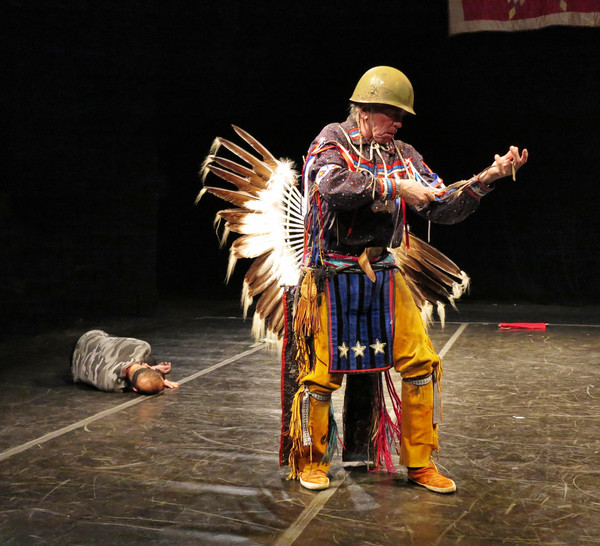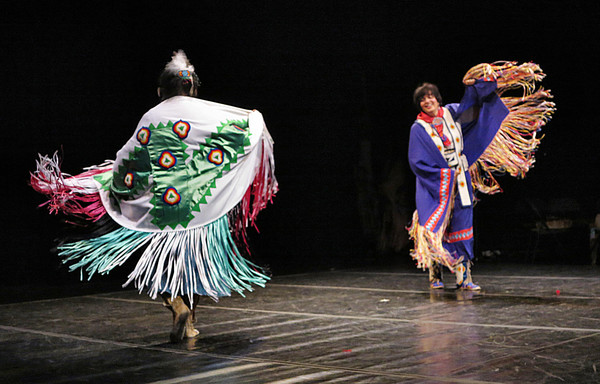Review: THUNDERBIRD AMERICAN INDIAN DANCE CONCERT AND POW WOW Celebrates Timeless Traditions Today

At a time when our nation is experiencing such heightened tension around immigrants and immigration, the descendants of the original Americans - who were shaping (quite literally through the Grass Dance) this land and living harmoniously within it for eons before most of our ancestors arrived - were celebrating aspects of their culture and history, some ancient, some more recent through the timeless and universal traditions of song and dance. And while not all of the dances and dancers are virtuosic (though some certainly are) in terms of impressiveness, every one from the simplest to the most complex is potent and loaded with meaning and significance harkening back to a heritage that could have been lost to time if not for this kind of preservation to continue it.
The 44th annual Thunderbird American Dancers Dance Concert and Pow Wow at Theater for the New City has become a time-honored tradition and was hosted by the company's charismatic artistic director Louis Mofsie, of Hopi/Winnebago descent, who acted as the Emcee and guide for the audience's journey into the many fascinating elements of a such a rich tapestry of traditions, history and lore. Like the mysterious "man of knowledge", don Juan Matus from author and anthropologist Carlos Castaneda's books, Mofsie does more than merely educates the attendees, he gets to the heart and soul behind it all. He also participates in the performances through percussion and vocal chants.
As the packed house took their seats they were greeted by the Henya Second Sons Singers from various tribes. The Robin Dance and Smoke Dance (Iroquois) preceded, where the pageantry of the ornate costumes evocative of colorful birds of paradise were revealed. And, just like in the animal kingdom the men were much more elaborately embellished than the female dancers -- plumes and all! Speaking of plumage, storyteller Matoaka Eagle from the Santo Domingo/Chickahominy tribes engaged her listeners with the tale of how the Rainbow Crow, renowned for her glorious feathers and elegant voice, got her coal black quills and unpleasant squak. Apparently, it was due to her bravery and determination to save the animals from the newly designed winter and snow, by petitioning the Creator and returning with his gift of fire -- though she become a bit blackened and burnt herself in transit from a place far beyond the sun.
Two of the dances that touched me most we some of the simplest -- the Stomp Dance and the Round Dance. In the Stomp Dance, it was the context that Mofsie gave that made it so touching. He recounted the sad reality of Native American children getting sent to boarding schools to essentially "brainwash their culture away." But the tribal kids were resilient. Even though they spoke many different tongues and each had their own traditions, they found a way to honor their collective indigenous spirit and blood by creating a new sort of language -- vocables -- that combed their various speeches and even interweaved some English as a common base they'd come to know together. The dance is simply, circular and playful as one would expect from children, yet it's message and the meaning behind it proclaims an unshakable devoting to their unified cultures and an act of rebellion against those who wished to erase their knowledge of their ancestry. Even some of the lyrics in English such as: "I've got trouble in my eye, I've got the blues" and "send me a letter in the mail, send it from the city jail," call to mind the same sentiments from the musical songs and styles of gospel and the blues -- also originated by an oppressed people, African Americans.
The other simple, yet profound dance -- the Round Dance -- was potent because of its participatory power. Mofsie explained that they did this dance when invited to Japan and everyone loved it. He then urged whomever was willing to get up and join the two circles of people, like one ring within another. It was an easy side to side step clockwise dance but the act of holding a stranger's hand and moving together, connecting as one unit, was very special.
This year a new dance called "Silent Echoes of Time," a collaboration between choreographer/conceiver/dancer Michael Taylor-Dancing Wolf (Choctaw/French) and dancer Allan Shooting Star (Lenape), set to a blend of traditional and modern, melancholic mood music provided by Rob Mastrini on guitar, percussion by Louis Mofsie (Hopi/Winnebago) and vocals by Matoaka Little Eagle. The contemporary dance piece imbued with traditional elements is a tribute to Veterans, particularly of the Vietnam War inspired by the creator's own personal experiences. In the performance, a troubled former soldier encounters his pure and untainted spirit self who guides him back to his own place of peace and acceptance. It explores PTSD and then healing through finding oneself again after feeling lost and blinded by such pain and trauma.
Interesting stories accompanied several of the most common Pow Wow dancers like the Hopi Eagle Dance -- which is mistakenly referred to as a "rain dance." The movement mimics the eagle in flight right before pending rain but it is not an attempt to magically call the water droplets from the sky, rather, it is a prayer dance asking the Creator to provide them with their life essentials. "You may go to a church or temple or mosque or synagogue but our people, we dance when we pray," Mofsie proudly proclaimed. The two who performed the piece outfitted in garments that would make the namesake bird of prey envious, were notably younger member of the primarily mature adults-based company -- a strikingly handsome young man and the smallest member, a girl of probably no more than ten who possessed the poise, grace and wisdom in the eyes of someone far beyond her years.
The Grass Dance and Jingle Dress Dance came from the Great Plains people, and it was easy to understand why when given the background story: when the nomadic tribes followed the buffalo, they'd set up camp by performing a dance that stomped down the tall grasses and gave them a flat space to lay their heads. The Jingle Dress Dance came to a mother of an ailing child in a vision with explicit instructions on how the dress and the dance should look -- legend has it, it worked! The exquisite dresses dripping with long metal decorations that twinkled and jingled gleefully from every place imaginable were as extravagant as an runway couture as the women (and the talented young girl) bounced in tight steps and crisscrossed feet. The sights and sounds called to mind other dance traditions from far away where women have adored themselves with resonant, musical and gilded accessories: Middle Eastern or Oriental Dance (also known as Bellydance) and Indian Kathak.
The Deer Dance from the Yaqui Tribes of Southern Arizona beautifully portrayed by Ciaran Tufford (Mayan/Cherokee) and Carlos Ponce (Mayan). The is the most narrative dance between and hunter and a deer (the costume is extraordinary and complete with a real deer head) in a battle that the animal fights nobly against but ultimately loses. The combination of delicacy and strength of the dancer makes the stately creature seem real and alive, its spirit present in the man who performs it. When the hunter kills the deer, he kneels to bless and thank it before also giving thanks to the Creator. If only such reverence could be commonplace today.
The end of the evening was akin to a sumptuous and lavish ball -- the Shawl Dance and the Fancy Dance from the Oklahoma tribes. In the Shawl Dance, the women (who are usually delegated to more simple steps and garments than the men and don't don the famous feathers) get to show off and the get their fringe flying too. The Fancy Dance is just what you'd envision -- ornately embellished costumes and showy movements. But the biggest excitement factor of the event was Michael Taylor-Dancing Wolf's Hoop Dance, where he seamlessly transformed no less than six hoops into eagle wings, encircled them around his body like a cage and jumped in and out of the circular objects, manipulating them with a trickster-like wink and ease, finally climaxing into the formation of a sphere -- the world.
If the Native Americans, as Mofsie suggested, dance their prayers then the Thunderbird American Indian Dance Concert and Pow Wow is a truly holy and spiritual experience that uplifted the attendees to heavenly realms, but more importantly, brought us all back down to earth, our roots and shared universal heritage of appreciating and worshiping the land and life within it.

Louis Mofsie - Hopi/Winnebago. Photo by James Rucinski

Matoaka Little Eagle - Santo Domingo/Chickahominy. Photo by Jonathan Slaff

Isabelle Cespedes - Maya/Cherokee/Cree/Pawnee, and Ciaran Tufford - Maya/Cherokee/Cree/Pawnee. Photo by Jonathan Slaff

Foreground: Allan Shooting Star (Lenape) and (behind) Michael Taylor-Dancing Wolf (Choctaw/French) in premiere performance February 1, 2019 of "Silent Echoes of Time," a tribute to Vietnam Veterans, choreographed by Michael Taylor-Dancing Wolf (Choctaw/French), set to traditional music including guitar by Rob Mastrini, percussion by Louis Mofsie (Hopi/Winnebago) and vocals by Matoaka Eagle (Chocktaw). Photo by Jonathan Slaff.

Ciaran Tufford - Maya/Cherokee/Cree/Pawnee, and Carlos Eagle Feather - Maya Pipil. Photo by Jonathan Slaff

Kitty Gabourel - Maya. Photo by Jonathan Slaff

Michael Taylor (Choctaw) in Hoop Dance. Photo by Jonathan Slaff.
Reader Reviews
Videos

